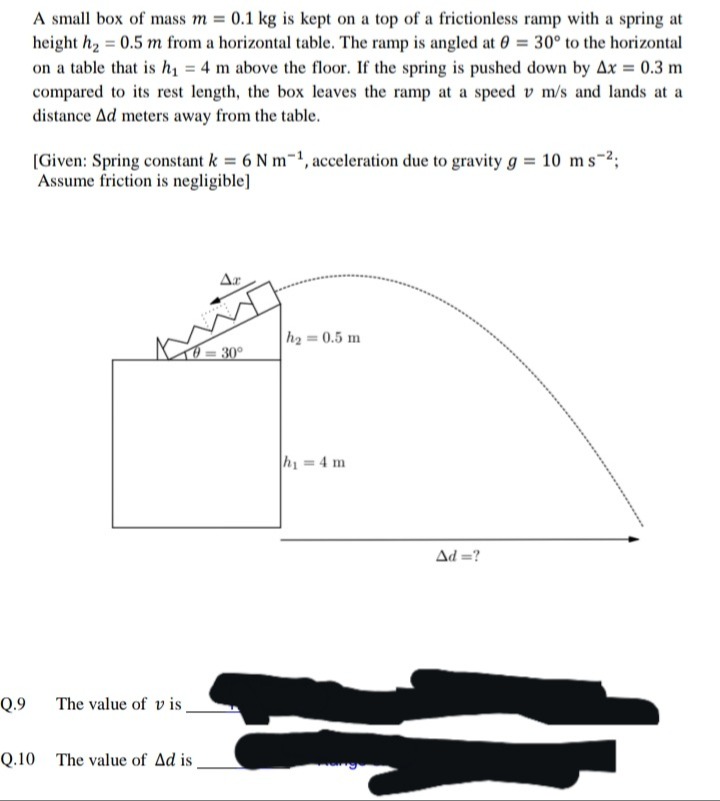Question
Question: A small box of mass $m = 0.1$ kg is kept on a top of a frictionless ramp with a spring at height $h_...
A small box of mass m=0.1 kg is kept on a top of a frictionless ramp with a spring at height h2=0.5 m from a horizontal table. The ramp is angled at θ=30∘ to the horizontal on a table that is h1=4 m above the floor. If the spring is pushed down by Δx=0.3 m compared to its rest length, the box leaves the ramp at a speed v m/s and lands at a distance Δd meters away from the table.
[Given: Spring constant k=6 N m−1, acceleration due to gravity g=10 m s−2; Assume friction is negligible]

Q.9: 1.55 Q.10: 1.38
Solution
Q.9: We use the principle of conservation of energy to find the speed v of the box when it leaves the ramp.
Initial energy:
Spring potential energy Usi=21k(Δx)2
Final energy:
Kinetic energy Kf=21mv2
Gravitational potential energy Ugf=mg(Δxsinθ)
By conservation of energy: 21k(Δx)2=21mv2+mg(Δxsinθ)
v2=mk(Δx)2−2gΔxsinθ
Given values: m=0.1 kg, k=6 N m−1, Δx=0.3 m, g=10 m s−2, θ=30∘.
sinθ=sin30∘=21.
v2=0.16×(0.3)2−2×10×0.3×21=5.4−3=2.4
v=2.4≈1.55 m/s
Q.10: The box leaves the ramp at a speed v=2.4 m/s at an angle θ=30∘ above the horizontal. The initial height of the box above the floor is H=h1+h2=4+0.5=4.5 m.
Initial velocity components:
vx=vcosθ=2.4cos30∘=2.4×23=1.8 m/s
vy=vsinθ=2.4sin30∘=2.4×21=0.6 m/s
The horizontal distance is Δd=vx×t, where t is the time of flight.
The vertical motion is described by yf=y0+vy0t+21ayt2.
Here, y0=H=4.5 m, yf=0, vy0=vy=0.6 m/s, ay=−g=−10 m/s2.
0=4.5+0.6t−5t2
5t2−0.6t−4.5=0
Using the quadratic formula t=2a−b±b2−4ac:
a=5, b=−0.6, c=−4.5
t=2(5)0.6±(−0.6)2−4(5)(−4.5)=100.6+90.6≈1.0293
Now, calculate Δd=vx×t=1.8×100.6+90.6≈1.3810≈1.38 m
